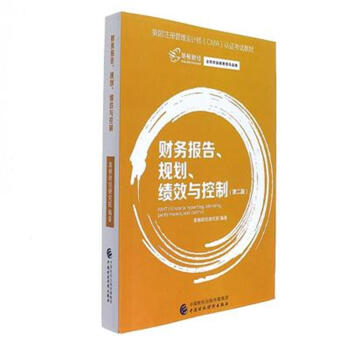![企业人力资源管理师专业英语 一二三四级适用 1+X职业技术·职业资格培训教材 第2版 [Enterprise Human Resource Professional]](https://pic.qciss.net/11735857/5b075f8fNfcce4ddf.jpg)

具体描述
内容简介
《企业人力资源管理师专业英语(第2版)》由人力资源和社会保障部教材办公室、中国就业培训技术指导中心上海分中心、上海市职业技能鉴定中心依据上海企业人力资源管理师(三级)(二级)职业技能鉴定细目组织编写。教材从强化培养操作技能,掌握实用技术的角度出发,较好地体现了当前全新的实用知识与操作技术,对于提高从业人员基本素质,掌握企业人力资源管理师专业英语的核心知识有直接的帮助和指导作用。
《企业人力资源管理师专业英语(第2版)》在编写中摒弃了传统教材注重系统性、理论性和完整性的编写方法,而是根据本职业的工作特点,从掌握实用操作技能和能力培养为根本出发点,采用模块化的编写方式。《企业人力资源管理师专业英语(第2版)》内容分为企业人力资源管理师(三级)和企业人力资源管理师(二级)两篇,内容分别包括人力资源规划、招聘与配置、培训与开发、绩效管理、薪酬管理、劳动关系管理、人力资源管理国际化。全书后附有企业人力资源管理师(三级)和企业人力资源管理师(二级)词汇表。
本教材可作为企业人力资源管理师(三级)(二级)专业英语职业技能培训与鉴定考核教材,也可供全国中、高等职业院校相关专业师生参考使用,以及本职业从业人员培训使用。
目录
第一篇 企业人力资源管理师(三级)VolumeⅠ Enterprise Human Resources Professional (level 3)
第一章 人力资源规划
Chapter one Human Resource Planning
1.1 什么是人力资源管理?What is Human Resource Management?
1.2 人力资源管理发展 History of Human Resource Management
1.3 人力资源管理的重要性 Importance of Human Resource Management
1.4 组织结构 Organizational Structure
1.5 工作分析 Job Analysis
1.6 工作设计 Job Design
1.7 人力资源规划的目的Aims of Human Resource Planning
1.8 人力资源规划的过程The Process of Human Resource Planning
第二章 招聘与配置
Chapter Two Recruit and Deploy
2.1 招聘计划与实施 Recruitment Plan and Implementation
2.2 招聘来源和渠道 Recruitment Source and Channel
2.3 招聘面试 Interview
2.4 知识测验Knowledge Test
2.5 心理测验 Psychological Test
2.6 人员录用程序 Employee Recruitment Procedure
2.7 人员配置原则 Employee Deployment Principles
第三章 培训与开发
Chapter Three Training and Development
3.1 培训需求分析目标 Aims of Training Needs Analysis
3.2 培训需求分析范围 Areas of Training Needs Analysis
3.3 需求分析的方法 Methods of Analyzing Needs
3.4 培训组织实施 Training organization and implementation
3.5 培训方法 Training Method
3.6 培训和学习规范 Training and Learning Specifications
3.7 培训评估 Training Evaluation
第四章 绩效管理
……
第五章 薪酬管理
第六章 劳动关系管理
第七章 人力资源管理国际化
第二篇 企业人力资源管理师(二级)
第一章 人力资源规划
第二章 招聘与配置
第三章 培训与开发
第四章 绩效管理
第五章 薪酬管理
第六章 劳动关系管理
第七章 人力资源管理国际化
附录
参考文献
精彩书摘
《企业人力资源管理师专业英语(第2版)》:The origin of manpower planning, the predecessor of modern HR planning, predates the beginnings of twentieth - century management theory. Among the first to raise the manpower-planning issue was the Frenchman Henri Fayol (1841 - 1925). His famous fourteen points of management are still considered valid today. One point had to do with what Fayol called stability of tenure of personnel. For Fayol, administrators bear responsibility to plan for human resources,ensuring that "human and material organization is consistent with the objectives, resources, and requirements of the business concern" ( Fayol,1930, p. 53). This point resembles some modern definitions of HRP. A deep recession in the late 1950s sparkled the need for a new way of thinking about management. People were increasingly viewed as assets-human resources-that could be either developed or wasted. This way of thinking became even more pronounced during the 1960s and 1970s, when the focus was on finding ways to design organizations and jobs to permit individuals greater latitudes of self - expression. Human creativity and job satisfaction are still two of the most important concems of management. The 1960s also spawned the term ruanpower
planning. Initial manpower planning efforts were typically tied to annual budgeting, as is still the case in some organizations. The implication was that people are expense items, since wages, salaries, and employee benefits constitute a major cost of doing business. Early planners were more often found in planning and budgeting departments than in personnel or HR departments, but they did manage to devote some attention to forecasting manpower demands. However, it was a need to budget, not a desire to stimulate creativity or increase productivity, that spurred them.
As the Human Resources school of management thought grew important throughout the 1970s,manpower planning activities gradually shifted to personnel departments. At the same time, the term human resources planning supplanted manpower planning. Likewise, personnel departments were renamed human resource departments, reflecting a new and more pronounced emphasis on the human side of the enterprise. Human resource practitioners and other contemporary observers of the management scene have expressed a growing awareness ever since the 1990s that people represent a key asset in competitiveness. While Western nations have long placed enormous faith in the power of technology to enhance productivity, the fact is that the greatest competitive gains stem from the exercise of human creativity to identify new products and services, find new markets and applications for existing products and services, and make use of the possible gains to be realized from technology. Without the creative application of human knowledge and skill, organizations would not be formed and would not thrive for long. Human beings thus represent intellectual capital to be managed, just like other forms of capital ( Brown, 1998).
……
前言/序言
用户评价
作为一名准备参加职业资格考试的考生,我最看重的是教材的系统性和针对性。这套书在这方面做得非常出色。它完全是按照最新的职业标准和考试大纲来构建知识体系的,脉络清晰到几乎不需要额外的学习地图。每一级的内容递进逻辑性极强,从基础的概念普及到高阶的综合应用,过渡得非常自然流畅,让人不会感到知识点的跳跃。更赞的是,教材中对那些容易混淆的关键术语和法条进行了重点标注和对比分析,用小卡片或者侧边栏的方式呈现,非常便于考前快速复习和查漏补缺。我感觉作者非常懂得我们备考的痛点,把复杂的信息结构化、模块化的功力非常深厚,这大大节省了我自己梳理知识框架的时间。
评分我得说,这套教材的知识覆盖面和深度真的超乎我的预期。它不仅仅是简单地罗列人力资源管理的各个职能模块,而是非常深入地探讨了背后的理论基础和最新的行业实践。尤其是在“战略人力资源管理”这一块,作者没有停留在传统的 HRM 概念上,而是引入了许多前沿的数字化转型和人才发展战略的内容,这对于我们应对当前复杂多变的商业环境非常有指导意义。阅读过程中,我发现它很好地平衡了理论的深度和实操的可行性。每一个章节后面都有一些非常贴近实际案例的思考题,这些题目不是那种死记硬背就能应付过去的,而是需要你结合自身工作经验进行深层次的分析和应用。这种“学以致用”的设计思路,让我在学习过程中不断地反思和调整自己的工作方法,收获远远超过了单纯的知识积累。
评分这本书的语言风格非常独特,它成功地在保持专业术语精确性的同时,避免了传统教材那种晦涩难懂的“学术腔”。作者似乎非常擅长用一种既严谨又略带亲和力的笔触来阐述复杂的管理学原理。很多原本需要反复琢磨才能领悟的理论,通过作者精妙的措辞和恰当的比喻,瞬间变得通俗易懂。例如,在讲解激励理论时,作者引入了一些生动的企业故事作为佐证,而不是生硬地引用实验数据,这让学习过程充满了乐趣。这种“会讲故事的专业教材”的特点,使得长时间阅读也不会感到枯燥乏味。对我来说,这种学习体验是至关重要的,它能确保我不是在“硬啃”知识,而是在真正地“吸收”和“理解”这些管理智慧。
评分我特别欣赏这套教材在国际视野和本土实践之间的平衡处理。在介绍人力资源管理的前沿趋势时,它没有盲目照搬西方的理论模型,而是非常审慎地讨论了这些模型在不同文化和经济背景下的适用性和调整需求。书中穿插了一些对比性的分析,清晰地指出了跨国企业在实施人力资源策略时需要注意的文化差异和法律法规的壁垒。这种全球视野和本土智慧相结合的叙事方式,让我对未来可能面临的跨文化管理挑战有了更深刻的认识。它教会我的不仅仅是“是什么”,更是“为什么”以及“如何根据实际情况进行优化”,这对于培养一名真正具备专业素养和全球化思维的人力资源管理者来说,是不可或缺的宝贵财富。
评分这套书的装帧设计真是让人眼前一亮,封面色彩搭配得非常专业,既有学术的严谨感,又不失现代气息。拿到手里感觉分量十足,就知道内容肯定很扎实。我对这套教材的排版布局印象深刻,文字的行距和字号选择得非常合理,阅读起来不费眼。最关键的是,书中的图表和示意图制作得极其精良,很多复杂的概念通过直观的图示一下子就清晰明了,这对于我们这些需要快速掌握核心知识的学习者来说简直太重要了。比如讲到组织结构设计或者绩效评估体系构建时,那些流程图和模型图简直就是教科书级别的示范。而且,全书的纸张质量也很好,即便是经常翻阅和做笔记也不会轻易损坏,这点对于长期学习的教材来说非常加分。总的来说,从视觉体验到实际使用感受,这套教材在设计细节上都体现出了高水平的制作标准,让人一上手就有种“选对了”的感觉,极大地提升了学习的积极性。
评分买来部门学专业英语的,感觉是从中文翻译过来的,表述不是很正宗,但是学学专业词汇够了。整体框架搭的还可以
评分加油,好好学习,天天向上!
评分一如既往的好,物美价廉
评分已经习惯在京东购物,方便、快捷,对商品也比较放心
评分很好,比较满意的一次购物。
评分非常满意的一次购买,宝贝不错,包装好,质量好!物流快,给个赞!
评分给媳妇买来学习用的,很实用,希望能帮助通过考试!
评分买了一堆专业书,送朋友的,朋友很满意
评分质量还可以,正品,可以购买
相关图书
本站所有内容均为互联网搜索引擎提供的公开搜索信息,本站不存储任何数据与内容,任何内容与数据均与本站无关,如有需要请联系相关搜索引擎包括但不限于百度,google,bing,sogou 等
© 2025 book.teaonline.club All Rights Reserved. 图书大百科 版权所有








![企业人力资源管理师三级辅导练习 1+X职业技术·职业技能培训教材 第2版 [Enterprise Human Resource Professional] pdf epub mobi 电子书 下载](https://pic.qciss.net/11755361/5b075f79Na280d423.jpg)











